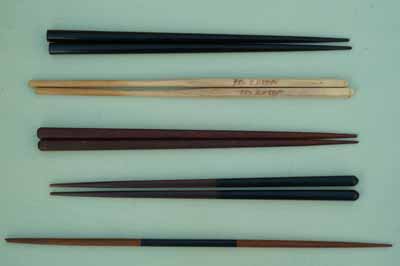Chopsticks. Roughly one-third of the world's population uses chopsticks to eat, particularly in China, Korea, Vietnam and Japan, where sticky rice is a staple food. It takes practice to learn to use them skilfully, but once mastered chopsticks are an extremely versatile and convenient utensil, used not only to hold food but to scoop, pinch, divide, jab, cut, mix or press - and in the kitchen while the meal is being prepared. The use of chopsticks has defined the way Japanese food is prepared, cooked and served - in manageable, bite-size pieces. Proper etiquette is also important; for example, food must never be passed from one set of chopsticks to another, and the opposite end of the chopsticks should be used to pick up foods from a shared dish. Chopsticks should never be left standing in a bowl of rice but placed side by side on the edge of the dish or on the table, sometimes on a hashioki, or chopsticks rest. They are made in various designs and materials, such as pottery, wood and bamboo, hashioki originated in ancient times; when offerings were made to ancestral deities, chopsticks for the gods were put on a special stand to keep them clean. Similarly today, the pointed ends of the chopsticks are often placed on hashioki, rather than on the surface of a table. While the use of hashioki in Japanese homes is often reserved for special occasions, their elegant and playful designs make them a popular collector's item for many people.
